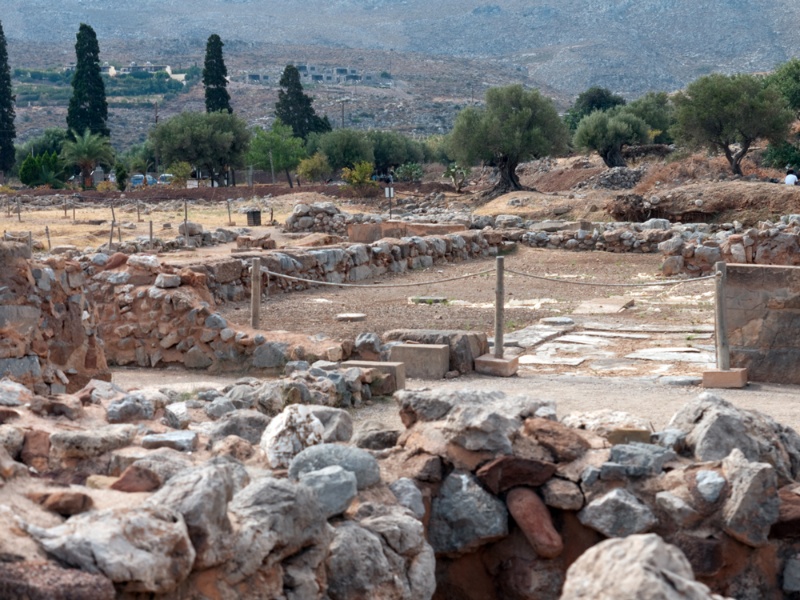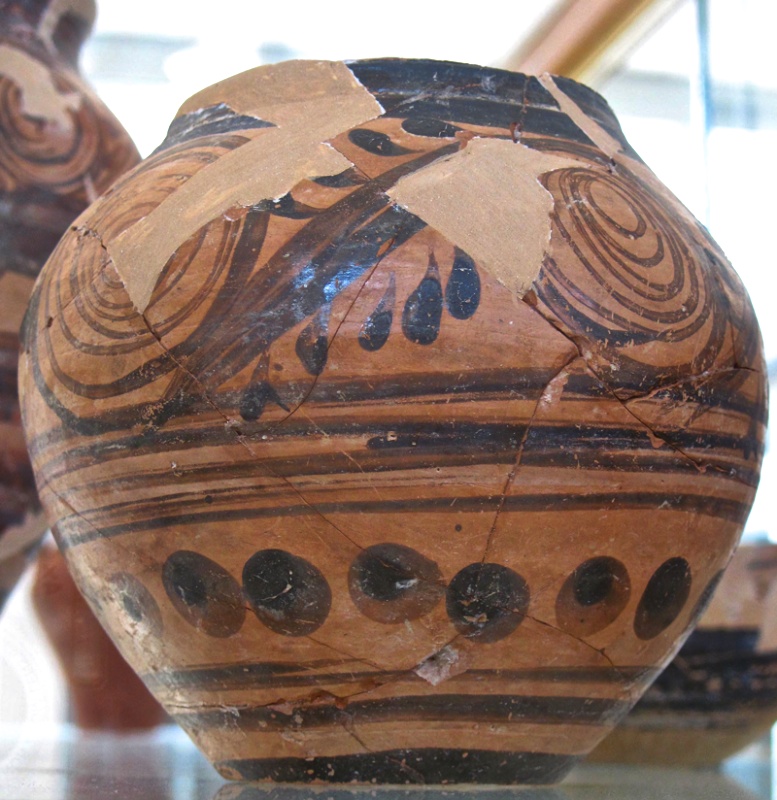-
 Palace remains #1Without a lot of onsite study, and probably some experienced guiding as well, we couldn’t be sure what we were looking at. Where we saw large open spaces there may have been outdoor courtyards or indoor halls. It’s hard to tell, since very little was left of the walls and nothing at all of the roofs. As I suspect most nonacademic visitors do, we mostly just tried to soak up some of the 4000-year-old atmosphere
Palace remains #1Without a lot of onsite study, and probably some experienced guiding as well, we couldn’t be sure what we were looking at. Where we saw large open spaces there may have been outdoor courtyards or indoor halls. It’s hard to tell, since very little was left of the walls and nothing at all of the roofs. As I suspect most nonacademic visitors do, we mostly just tried to soak up some of the 4000-year-old atmosphereTo leave this gallery...
-
 Palace remains #2This picture takes in most of the palace area (another part of the site is thought to have been a town just outside it). As you can see, we had the place almost to ourselves. When we arrived, a gang of workmen were doing something in an area just outside the reconstructed site. (Based on the way they were going at it, I'd judge that the job had nothing to do with archaeology.) In this picture you can see them gathered under a tree at the upper left—probably a lunch or smoking break. There were no more than half a dozen, but they outnumbered the visitors.
Palace remains #2This picture takes in most of the palace area (another part of the site is thought to have been a town just outside it). As you can see, we had the place almost to ourselves. When we arrived, a gang of workmen were doing something in an area just outside the reconstructed site. (Based on the way they were going at it, I'd judge that the job had nothing to do with archaeology.) In this picture you can see them gathered under a tree at the upper left—probably a lunch or smoking break. There were no more than half a dozen, but they outnumbered the visitors.To leave this gallery...
-
 Road to the sea (maybe)In the narrative, I described this as the road that led from the palace through the town and on to the local seaport. However, the official map doesn't say anything about this, and I may be totally wrong. About all I’m sure of is that it didn’t originally lead to the utility pole you can see at the top.
Road to the sea (maybe)In the narrative, I described this as the road that led from the palace through the town and on to the local seaport. However, the official map doesn't say anything about this, and I may be totally wrong. About all I’m sure of is that it didn’t originally lead to the utility pole you can see at the top.To leave this gallery...
-
 Cistern and occupantAlthough several sources said that there were a lot of turtles at the site, this is the only one we saw. This cistern was almost the only feature I was able to identify easily on the map, which shows it as contained in the “Hall of the Cistern.” I would have thought a cistern would be outdoors, but probably there was an opening in the roof. I didn't see any sign of the drainpipe arrangements we'd seen at Knossós and Agía Triáda. What keeps the cistern full today is not rainfall, but the local water table coming closer to the surface as the east end of Crete sinks gradually into the sea.
Cistern and occupantAlthough several sources said that there were a lot of turtles at the site, this is the only one we saw. This cistern was almost the only feature I was able to identify easily on the map, which shows it as contained in the “Hall of the Cistern.” I would have thought a cistern would be outdoors, but probably there was an opening in the roof. I didn't see any sign of the drainpipe arrangements we'd seen at Knossós and Agía Triáda. What keeps the cistern full today is not rainfall, but the local water table coming closer to the surface as the east end of Crete sinks gradually into the sea.To leave this gallery...
-
 Minoan pottery #1We took he rest of these pictures later, in the Archaeological Museum at Sitía. I know that most of the pottery was found at Káto Zákros, but some pieces may be from other Minoan sites in this part of Crete. The very best items were carried off to Iráklio (and probably to Athens as well), but there were plenty of fine pieces left for Sitía, the capital of this eastern region.
Minoan pottery #1We took he rest of these pictures later, in the Archaeological Museum at Sitía. I know that most of the pottery was found at Káto Zákros, but some pieces may be from other Minoan sites in this part of Crete. The very best items were carried off to Iráklio (and probably to Athens as well), but there were plenty of fine pieces left for Sitía, the capital of this eastern region.
It's a shame that pottery doesn’t survive earthquakes and similar disasters in one piece, making extensive patching necessary. But the Minoan style has so much vitality that even these cautious reconstructions are a joy to look at. I wish we could have seen these vessels when they were new!
No more comments—just pictures. We hope these pots and pitchers make you feel as cheerful as they made us.To leave this gallery...
















